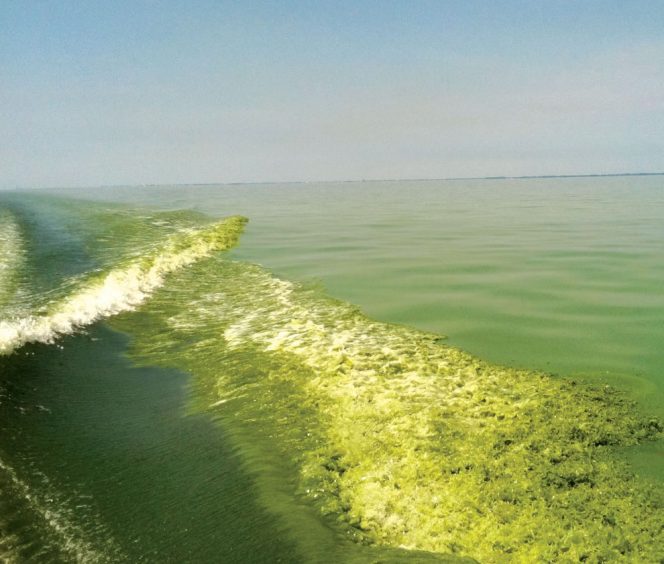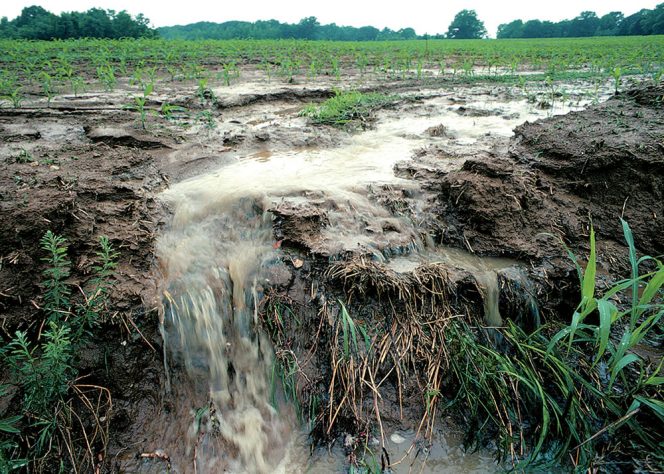Tom Zimnicki
BioCycle January 2019
In the first edition of The Lorax (1971), Dr. Seuss used Lake Erie as a punch line, “They’ll walk on their fins and get woefully weary in search of some water that isn’t so smeary. I hear things are just as bad up in Lake Erie.” After the implementation of the Clean Water Act and years of intense work by state and federal officials to limit industrial pollution entering Lake Erie, water quality vastly improved.
Over 40 years later and Lake Erie is consistently back in the news due to water quality conditions — specifically the presence of harmful algal blooms (HABs). HABs can diminish recreational opportunities and at times, produce harmful toxins that in 2014 forced the City of Toledo to shut off water to over 500,000 residents. Algal growth in Lake Erie is driven by numerous factors including lake depth and temperature, however the most important cause is excessive nutrient inputs, specifically phosphorus. Recognizing the outsized role that excessive phosphorus plays in driving HAB formation, the United States and Canada committed to phosphorus reduction targets in 2016 under the Great Lakes Water Quality Agreement. Both governments set goals for reducing total phosphorus (TP) and soluble reactive phosphorus (SRP) entering the Western Basin of Lake Erie by 40 percent.
The water quality issues of the 1970s were generally a result of industrial point source dischargers and inadequate sewage treatment plants. While point sources remain a contributor, today the majority of phosphorus inputs to Lake Erie are from nonpoint sources. And in the Western Basin of Lake Erie, where HABs are common, agriculture remains one of the largest nonpoint source contributors of phosphorus.
“Soil Health”
Millions of dollars are invested annually by local, state, federal, and private initiatives to curb phosphorus inputs through farm conservation practices. The most commonly implemented are reduced/no-tillage and cover crops. Increasingly, these practices are also promoted as methods to achieve “soil health” and improve long-term production on agricultural fields. The thinking goes that improved soil health allows for better control of water in fields, improves nutrient cycling, limits erosion and nutrient runoff, and ultimately benefits water quality.
While ”soil health” is a goal identified in the U.S. EPA’s Domestic Action Plan for Lake Erie, the benefits of soil health and the path to achieve it remains hazy for large-scale watersheds like Lake Erie. Some may object to the notion that the path for soil health revitalization is hazy. Certainly there are examples and research on how improvements to soil parameters may result in improved crop yields, changes in edge-of-field water quality, or even watershed quality benefits as seen in the Soils for Salmon project in Washington State that highlights the role of soil organic matter.
However, in the world of (watershed-scale) nutrient reduction planning, both state and federal governments increasingly rely on predictive models that estimate the benefit of a particular best management practice (BMP). Countless research studies quantify the reduction in phosphorus and nitrogen in surface runoff that passes through an edge-of-field grass buffer strip. By quantifying the benefit of one buffer strip, planners can estimate, how many pounds of nitrogen could be reduced using buffer strips on 15 percent of agricultural fields in the watershed. The ability to (accurately) predict the benefits of a specific BMP at a watershed-scale is crucial when it comes to state and federal nutrient management planning as it allows officials to plan which BMPs may be most effective in a given landscape.
Unfortunately, not all conservation practices, or practices focused on improving soil health, are clearly defined in these watershed models. For instance, the use of compost and resulting changes in soil processes are highly complex and not holistically incorporated in models. In the context of compost application, a more defined connection between compost, soil health, and water quality is vital for inclusion in predictive watershed modeling and consequently, nutrient management plans.
Soil Health, Water Quality Connection
Research has demonstrated how changes to soil health may impact local conditions. However, there is generally a lack of predictability for watershed scale (“at-scale”) changes resulting from improved or diminished soil health. To increase our understanding of how to quantifiably connect soil health with water quality at-scale, the Michigan Environmental Council, with support from the Cooperative Institute for Great Lakes Research (CIGLR), convened a summit of 23 expert researchers and practitioners in soil health and/or watershed modeling systems to address this issue.

Lake Erie’s water quality vastly improved after implementation of the Clean Water Act. Over 40 years later, Lake Erie is consistently back in the news due to harmful algal blooms. Photo courtesy of Tom Zimnicki
Several themes emerged over the 2-day summit. First, defining “soil health” in the context of agricultural production is vastly important. While the U.S. Department of Agriculture defines soil health as, “the continued capacity of soil to function as a vital living ecosystem that sustains plants, animals, and humans,” it remains a fairly nebulous, catchall term that describes “good stuff that makes soil productive.” Reviewing a list of accepted soil health processes and functions from institutions like Cornell University and USDA, summit participants narrowed the list of soil health parameters to hydrologic function/capacity, nutrient retention/cycling, and changes in crop yield, as these are likely most applicable to agriculture.
A related theme from the summit was the need for data and field validation research that can quantify the response of these soil health parameters to various BMPs under diverse field conditions. Absent robust and diverse datasets it will be difficult to justify the more complete integration of soil health parameters in watershed models and consequently, nutrient reduction planning. It is important that as researchers and practitioners implement BMPs on agricultural fields — for example, application of compost — data is collected at field-scale to demonstrate the resulting benefits. Given the diversity of agricultural operations (e.g. crop rotations, soil type, slopes, precipitation, etc.) it will be important to catalog field conditions to better understand how practices like compost use impact soil health and water quality in highly varied systems.
Changing Behavior
Summit participants also recognized the importance of farmer adoption of conservation practices. Within Midwestern agriculture, countless resources have been poured into promoting and assisting implementation of fairly basic practices like no-tillage and cover crops, yet overall adoption remains relatively low. This suggests that despite access to resources and research that illustrate cost savings to producers who implement these practices, other factors are at play that stunt overall adoption. Given that soil health encompasses a much broader and more loosely defined set of criteria and practices, it is assumed adoption rates will be even lower overall.
To better understand farmer perceptions and preferences with regard to conservation practice adoption in Michigan, the Michigan Environmental Council, Michigan Agribusiness Association, and Michigan State University (with support from the MI Department of Agriculture and Rural Development) have recently started coordinating and hosting a series of roundtable focus groups with farmers throughout the state. Discussions will focus on drivers of farmer conservation adoption and farmer response to new, innovative conservation planning strategies.
Long term, the goal of this research is to marry the technical, data driven needs outlined in the summit with the social science findings of the farmer roundtable discussions. This will hopefully provide valuable information to stakeholders and researchers regarding data needs and methods for communicating conservation opportunities to the agricultural community.
At the COMPOST 2019 Conference, I will discuss the intersections of agriculture, compost, and water quality policy development, expanding on this article to: 1) Showcase select findings, including recommendations from both the summit and farmer roundtables; and 2) Lay out a roadmap for possible future work and collaborations.
For example, a priority identified during the summit is the need for more robust edge-of-field water quality monitoring data, especially from practices like compost application. Compost professionals working within agriculture could address this priority by exploring opportunities to collect field data when working with farmers. This will help build the justification for compost use as a method for improving water quality. While scheduling the roundtables with farmers, we’ve heard that farms want, and need, to understand the return on investment/value of applying compost as an organics amendment rather than just applying raw manure. Through intentional planning and targeted resource allocation, the composting industry can play a more pivotal role in nutrient reduction planning.
In the mid-1980s Dr. Seuss removed the reference to Lake Erie after it was pointed out that the quality of the lake had drastically improved. My hope is that improving soil health at a broad scale will help reclaim Lake Erie from its current woes. Otherwise, we might need to put a reference to it back in The Lorax.
Tom Zimnicki is Agriculture Policy Director at the Michigan Environmental Council (Lansing, MI). His work focuses primarily on addressing issues at the intersection of agriculture and water quality.














